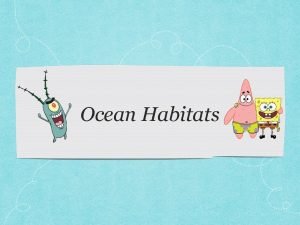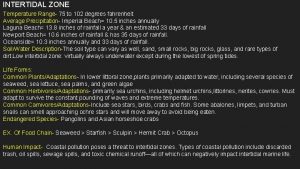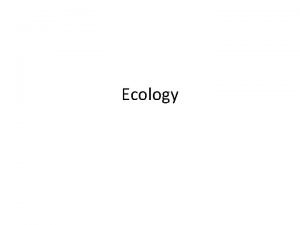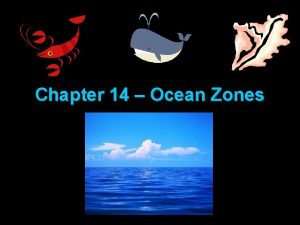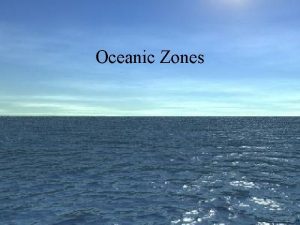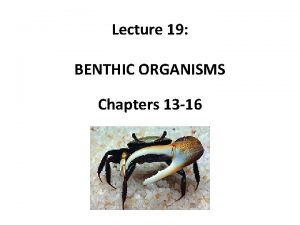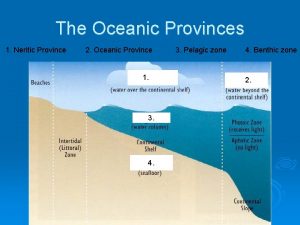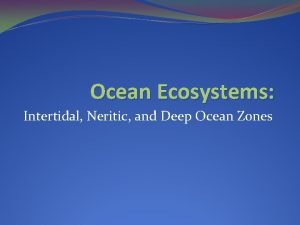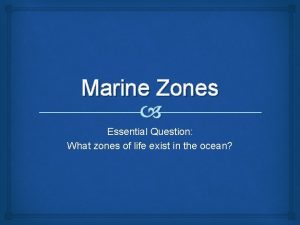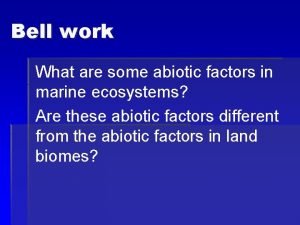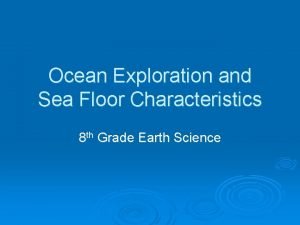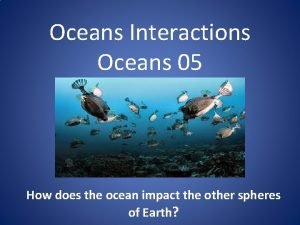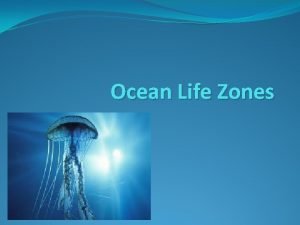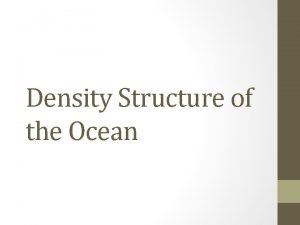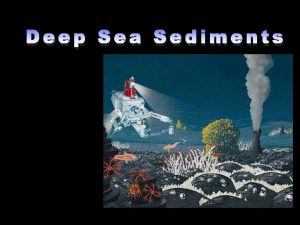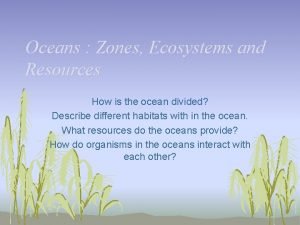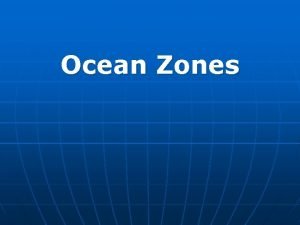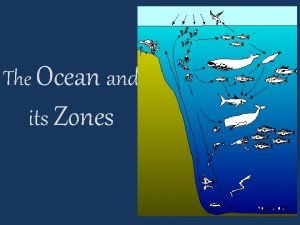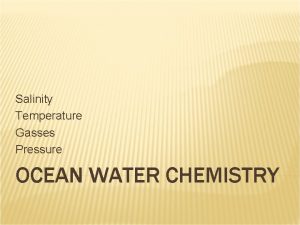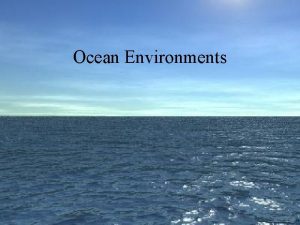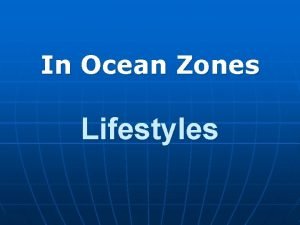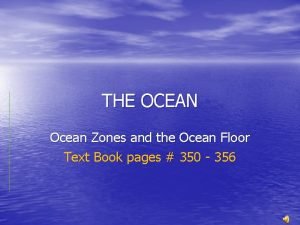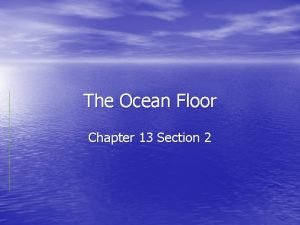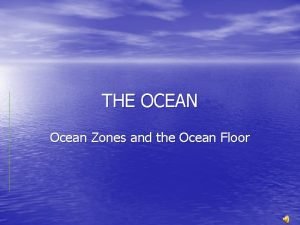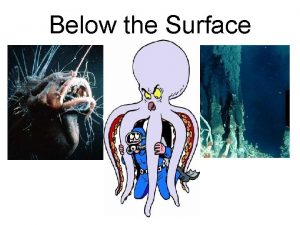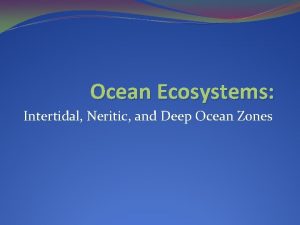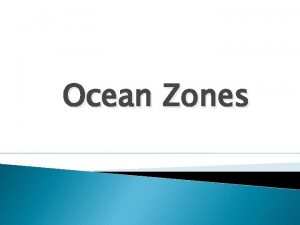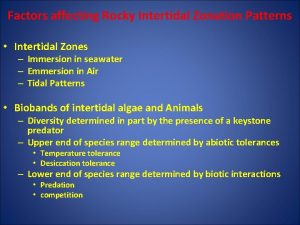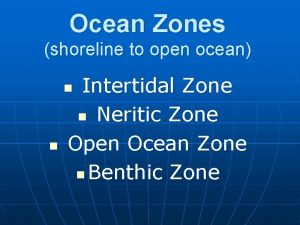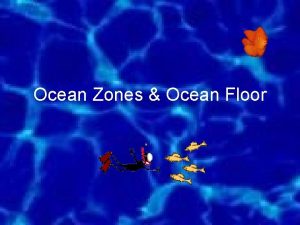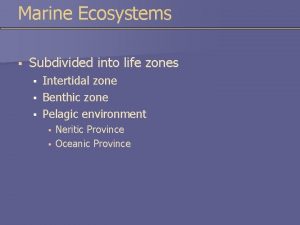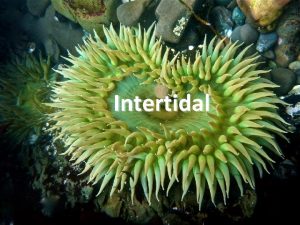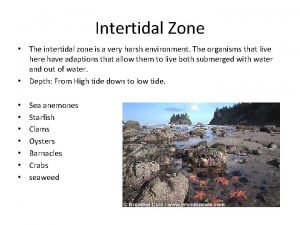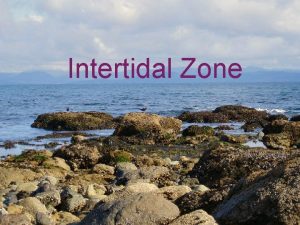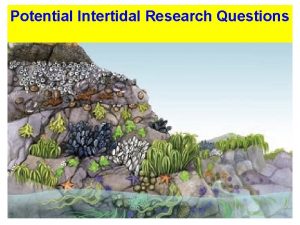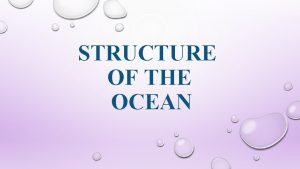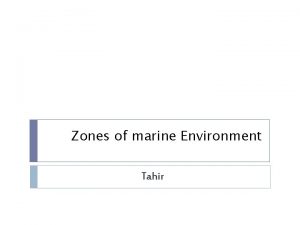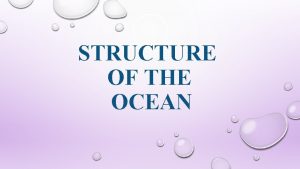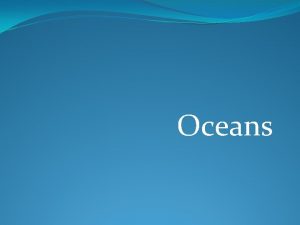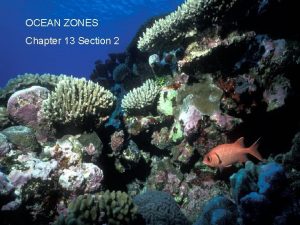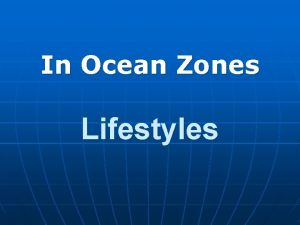Ocean Ecosystems Intertidal Neritic and Deep Ocean Zones












































- Slides: 44

Ocean Ecosystems: Intertidal, Neritic, and Deep Ocean Zones

Warm Up & Spiral November 4 1. How are surface currents created? 2. How are deep ocean currents created? 3. What are 2 factors that affect the density of water? 4. What is upwelling? Objectioves: 8. E. 1. 1/1. 2 -TSWU that the ocean is divided up into smaller ecosystems including coral reefs, kelp forests, deep ocean, neritic zone, and surface zone. -TSWU the types of organisms that live in each marine ecosystem. Essential Question: -What types of organisms can be found in each marine ecosystem? -What types of ecosystems can be found in the ocean?

Warm Up November 4 1. Describe what happens in the ocean during upwelling. 2. What causes upwelling? Objectives: 8. E. 1. 2 -TSWU the hydrosphere including the differences and similarities between the intertidal, neritic, and deep ocean zones. Essential Question: -What is the difference between the intertidal, neritic, and deep ocean zones?

What is Upwelling? �Winds blowing across the ocean’s surface pushes water away. �Cold water rises from deep in the ocean. �The cold water brings nutrients from the deep ocean to the surface. �Why is upwelling good for organisms at the oceans surface?

Once water leaves the estuary, it heads out to the ocean

Oceans make up about 70% of our Earth surface.

As salinity increases, water’s density INCREASES.

We should already know which is more dense, solid water or liquid water. Which is more dense solid water or liquid water? ?

But is cold water more or less dense than warm water?

Is cold water more dense than warm water? While ice is LESS dense than liquid water, cold water is MORE dense than warm water.

Answer ANALYSIS QUESTIONS: 1. Two (2) ways to change the density of ocean water are: ________ & ________ 2. The more salt dissolved in water, the ____ dense this ocean water is. 3. The colder liquid water gets, the _____ dense the ocean gets. 4. What moves surface currents: _________ 5. What moves deep water currents: changes in water _____

Answer ANALYSIS QUESTIONS: 1. Two (2) ways to change the density of ocean water are: ________ & ________ 2. The more salt dissolved in water, the ____ dense this ocean water is. 3. The colder liquid water gets, the _____ dense the ocean gets. 4. What moves surface currents: _________ 5. What moves deep water currents: changes in water _____

All our oceans are connected by surface & deep water currents. Surface & deep currents move all Earth’s salt water around

All our oceans are connected by surface & deep water currents. Surface & deep currents move all Earth’s salt water around

Deep water currents are driven by changes in ocean water density. �By changes in salinity and temperature make some ocean water sink or rise creating deep ocean currents!

Deep water currents are driven by changes in ocean water density. �By changes in salinity and temperature make some ocean water sink or rise creating deep ocean currents!

Without currents moving salt water around our planet, our daily temperatures would be much more EXTREME.

No Surface & deep currents moderates temperatures across the globe! Why? Because salt water doesn’t FREEZE or EVAPORATE as fast as fresh water! big s ng i w

Why are oceans SALTY? 1. 2. 3. 4. Eroding land Volcanic emissions Atmospheric deposition Biological & chemical reactions at the sea floor

Why are oceans SALTY? 1. 2. 3. 4. Eroding land Volcanic emissions Atmospheric deposition Biological & chemical reactions at the sea floor

Once water leaves the estuary, it heads out to the ocean

How many ocean ecosystems are there?

Our ocean has many ecosystems: 1. 2. 3. 4. 5. 6.

Our ocean has many ecosystems: 1. Intertidal – estuaries, shore 2. 3.

Our ocean has many ecosystems: 1. Intertidal – estuaries, shore 2. Coral Reefs 3.

Our ocean has many ecosystems: 1. Intertidal – estuaries, shore 2. Coral Reefs 3. Kelp Forests

Our ocean has many ecosystems: 1. Intertidal – estuaries, shore 2. Coral Reefs 3. Kelp Forests 4. Deep Ocean

Our ocean has many ecosystems: 1. Intertidal – estuaries, shore 2. Coral Reefs 3. Kelp Forests 4. Deep Ocean 5. Surface Zone – this is the sunlit zone

Our ocean has 3 ecosystems: 1. Intertidal – estuaries, shore 2. Coral Reefs 3. Kelp Forests 4. Deep Ocean 5. Surface Zone 6. Neritic Zone

Our ocean has many ecosystems: 1. Intertidal – estuaries, shore 2. Coral Reefs 3. Kelp Forests 4. Deep Ocean 5. Surface Zone 6. Neritic Zone 7. Ocean Floor

Our ocean has many ecosystems: WE WILL BE LOOKING AT EACH OF THESE ECOSYSTEMS OVER THE NEXT FEW DAYS, BUT 1 ST LETS LOOK AT SOME SAMPLES OF LIFE…

Our ocean has many ecosystems but: The ocean has 3 main ecosystems

Our ocean has many ecosystems: 3 Main zones in the ocean include: 1. SHORELINE = INTERTIDAL ZONE 2. CONTINENTAL SHELF = NERITIC ZONE 3. DEEP ZONE = BENTHIC ZONE

Our ocean has many ecosystems: 3 Main zones in the ocean include: Intertidal Zone 1. SHORELINE = INTERTIDAL ZONE � Located along the shore � Towards the mangrove forests and salt marshes but not that far. � Located at the area between the high tide and low tide mark.

Our ocean has many ecosystems: 3 Main zones in the ocean include: Intertidal Zone 2. CONTINENTAL SHELF = NERITIC ZONE � Located along the continental shelf � Kelp forests and coral reefs are found here. � Sunlight does penetrate this zone. � Photosynthesis occurs here.

Our ocean has many ecosystems: 3 Main zones in the ocean include: Intertidal Zone 3. DEEP ZONE = BENTHIC ZONE � Benthic vents are located here at the bottom of the ocean. � Photosynthesis does not occur here because NO sunlight can reach this far. � Organisms use a process known as chemosynthesis to survive at this depth. � Tube worms feed on sulfur eating bacteria here.

Ocean Life Lab Work in your pairs

Do the following table in your notes: Organism 1 2 3 4 5 6 7 Draw an illustration of the organism. Describe the organism. Identify the organism. Which ocean zone does the organism live in? Write two interesting fact about the organism.

Each pair will get a bag of ocean life and you must classify at least 5. �FILL IN YOUR TABLE COMPLETELY!

Each pair will get a bag of ocean life and you must classify at least 5. �FILL IN YOUR TABLE COMPLETELY! �WHEN DONE, PICK YOUR MOST INTERESTING SPECIMEN AND PRESENT IT TO CLASS!

Clean-up…. �Place your shells back onto the Zip lock bag and place in the bin. �Place the Shell guide back in the bin �Place your bins on top of your textbook.

Our ocean has 3 main ecosystems: Intertidal zone (ALSO KNOWN AS THE Littoral zone…shoreline zone) 2. Neritic zone (ALSO KNOWN AS THE continental shelf) 3. Deep ocean (ALSO KNOWN AS THE benthic zone) 1.

Our ocean has 3 main ecosystems: Intertidal (aka…littoral zone…shore line zone) 2. Neritic zone (aka…continental shelf) 3. Deep ocean (aka…benthic zone) 1.

Our ocean has 3 main ecosystems: 1. Intertidal zone(aka…littoral zone…shoreline zone) 2. Neritic zone (aka…continental shelf) 3. Deep ocean (aka…benthic zone) Benthic Vents
 Intertidal ocean zone
Intertidal ocean zone Youtube.com
Youtube.com How do littoral zones differ from riparian zones?
How do littoral zones differ from riparian zones? Intertidal zone temperature
Intertidal zone temperature Foundation species examples
Foundation species examples Intertidal zone worksheet answers
Intertidal zone worksheet answers Animals that live in the abyssopelagic zone
Animals that live in the abyssopelagic zone Suspension and deposit feeding
Suspension and deposit feeding Hadopelagic
Hadopelagic Ocean and lake zones
Ocean and lake zones Neritic ecosystem
Neritic ecosystem Neritic zone
Neritic zone Facts about the neritic zone
Facts about the neritic zone Neritic zone biotic life
Neritic zone biotic life Neritic zone
Neritic zone Ocean depth zones
Ocean depth zones Ocean zones graphic organizer
Ocean zones graphic organizer Ocean life zones
Ocean life zones Hydrosphere mind map
Hydrosphere mind map Ocean density zones
Ocean density zones 4 zones of the ocean
4 zones of the ocean 3 ocean zones
3 ocean zones Vertical ocean zones
Vertical ocean zones Horizontal zones of the ocean
Horizontal zones of the ocean Ocean light zones
Ocean light zones Buckshot barnacle
Buckshot barnacle Benthic zone
Benthic zone Youtube youtube youtube
Youtube youtube youtube Deep asleep deep asleep it lies
Deep asleep deep asleep it lies Deep forest: towards an alternative to deep neural networks
Deep forest: towards an alternative to deep neural networks 深哉深哉耶穌的愛
深哉深哉耶穌的愛 Smooth nearly flat region of the ocean floor
Smooth nearly flat region of the ocean floor Deep valley on the ocean floor
Deep valley on the ocean floor Slidetodoc.com
Slidetodoc.com My love is like a red rose figure of speech
My love is like a red rose figure of speech Deep sea abiotic factors
Deep sea abiotic factors Deep ocean trenches
Deep ocean trenches Chapter 15 ocean water and ocean life answer key
Chapter 15 ocean water and ocean life answer key Types of divergent plate boundary
Types of divergent plate boundary Ocean ocean convergent boundary
Ocean ocean convergent boundary Convergent boundary
Convergent boundary Ocean ocean convergent boundary
Ocean ocean convergent boundary Seafloor spreading demonstration
Seafloor spreading demonstration Ocean to ocean convergent boundary
Ocean to ocean convergent boundary Red ocean vs blue ocean
Red ocean vs blue ocean
